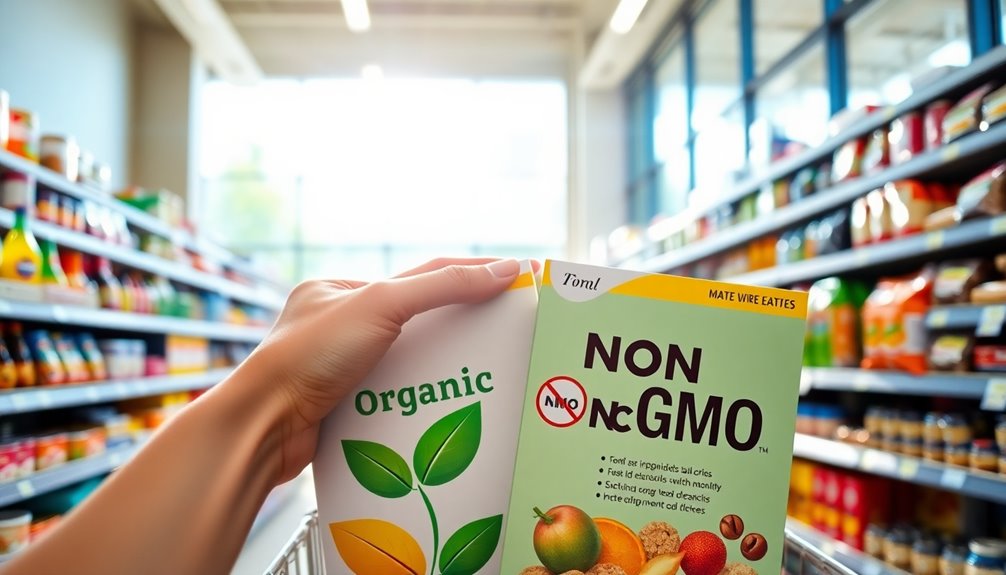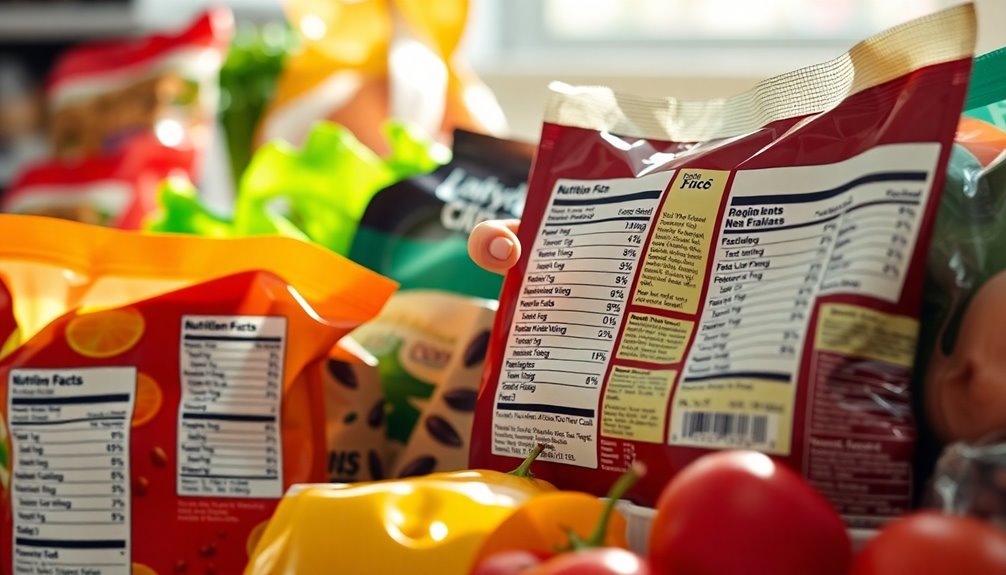Food labels play an essential role in helping you make mindful choices about what you eat. They provide vital information, like serving sizes and ingredient lists, which guide you in understanding the nutritional value of packaged foods. By paying attention to the sequence of ingredients, you can avoid hidden sugars and unhealthy additives. Additionally, labels highlight allergens, ensuring your safety and health. Be cautious of misleading health claims and marketing tactics. By equipping yourself with knowledge from food labels, you empower your choices for a healthier lifestyle. There's so much more about understanding food labels that can enhance your decision-making process.
Key Takeaways
- Food labels provide essential information on serving sizes and servings per container, aiding in portion control and dietary planning.
- Ingredient lists reveal the composition of products, allowing consumers to avoid additives and prioritize whole, plant-based ingredients.
- Nutritional information highlights calories and sugar content, helping individuals make informed choices to maintain a balanced diet.
- Understanding health claims and certifications empowers consumers to differentiate between truly healthy options and marketing tactics.
- Mindful label reading promotes awareness of allergens and hidden ingredients, supporting safer dietary choices for individuals with specific health needs.
Understanding Food Labels

Understanding food labels can feel overwhelming at times, but they're necessary tools for making healthy choices. When you pick up a product, take a moment to examine the label design. It's not just about aesthetics; it provides vital packaging information that can guide your decisions.
Start by looking for the "Serving Size" and "Servings Per Container." This lets you know how much of the product is considered one serving, which is important for managing portion sizes.
Next, focus on the ingredients list. Ingredients are listed in descending order, meaning the first few items are the most prevalent. If you see familiar, wholesome ingredients, it's a positive sign.
Be cautious of products with lengthy ingredient lists filled with additives or artificial substances. These usually indicate lower-quality options. Additionally, pay attention to claims like "organic" or "natural." While they sound appealing, it's crucial to verify what these terms mean in the context of that specific product. Furthermore, be aware that many traditional breads contain high glycemic index ingredients that can lead to blood sugar spikes.
Nutritional Information Breakdown

Delve into the nutritional details on food labels to make well-informed choices about your diet. Understanding the breakdown of nutrients can enhance your ability to eat consciously. By focusing on key components, you can align your food choices with your health goals, whether you're calorie counting or simply working towards better nutrition.
When you examine the nutritional information, pay special attention to these three aspects:
- Calories: Knowing how many calories are in a serving helps you stay within your daily limits. This is pivotal for weight management and overall wellness.
- Sugar Content: Excessive sugar can lead to health issues, such as obesity and diabetes. Always check how much added sugar is in a product to avoid hidden sugars.
- Serving Size: Often overlooked, the serving size influences your perception of calories and nutrients. Adjust your intake based on the number of servings you consume.
Additionally, understanding the importance of meal planning can further support your dietary choices and enhance your overall health journey.
Ingredient Lists Explained

Ingredient lists on food packages provide a clear glimpse into what you're actually consuming. By reading these lists, you can make informed decisions about the foods you choose to include in your diet. The order of ingredients matters, as items are typically listed by weight, with the most important ingredients appearing first. This helps you understand the primary components of the product and whether it's aligned with your dietary needs.
Be sure to look out for common allergens such as peanuts, tree nuts, dairy, wheat, soy, and eggs. These allergens are often highlighted in bold or a separate section, making it easier for you to identify them quickly. If you or someone you care about has food allergies, knowing how to read ingredient lists is vital for avoiding adverse reactions.
Moreover, watch for hidden ingredients that may not be immediately obvious. Many processed foods contain additives, preservatives, or artificial flavors that could impact your health or dietary preferences. For instance, ingredients like high fructose corn syrup or various emulsifiers may not sound harmful, but they can have significant health implications. Additionally, understanding the importance of plant-based ingredients can help you select healthier options that align with a nutritious diet.
Serving Sizes and Portions

Most people overlook the significance of serving sizes and portions when reading food labels, but they can greatly impact your dietary choices. Understanding serving sizes helps you practice portion control, which is vital for maintaining a healthy lifestyle. Remember, the serving size listed isn't just a suggestion; it's a guideline that reflects the amount you should ideally consume in one sitting. When you ignore this detail, you may unintentionally overeat, leading to unwanted weight gain.
To make mindful choices, consider these key points:
- Check the serving size: Align your meals with the recommended serving to stay within your dietary goals.
- Compare products: Different brands may have varying serving sizes, affecting calories and nutrients. Always read labels for accurate information.
- Use measuring tools: Invest in measuring cups or a food scale to make sure you're consuming the right portions.
Label accuracy is essential in making informed decisions. If a product lists a serving size that's too small, you mightn't realize how many calories or grams of sugar you're actually consuming. This is particularly important when snacking or indulging in processed foods, where portion sizes can easily spiral out of control. By being mindful of serving sizes and practicing portion control, you can enhance your eating habits and foster a healthier relationship with food. Additionally, research suggests that understanding dietary guidelines can further support effective portion management and contribute to overall wellness. Remember, awareness is the first step towards making better choices!
The Importance of Allergens

Understanding serving sizes is just one aspect of making informed food choices; knowing about allergens is equally significant for your health and safety. Food allergies can lead to severe reactions, and awareness is your first line of defense. Always check food labels for allergen information, especially if you have a known allergy.
Cross-contamination risks are a notable concern. Even trace amounts of an allergen can trigger a reaction in sensitive individuals. When shopping or dining out, it's essential to ask questions and understand the preparation methods used.
For instance, if your meal is prepared in a kitchen that also handles allergens, you could be at risk, even if the dish you ordered doesn't contain them.
Another factor to keep in mind is hidden allergens. Some ingredients may not be immediately recognizable as allergens, making it vital to scrutinize labels carefully.
For example, certain sauces or dressings might contain nuts or dairy, so always look beyond the obvious.
Being part of a community that values health means you can share your experiences and learn from others. Don't hesitate to communicate your dietary needs, whether at home or in restaurants.
This proactive approach not only safeguards your health but also helps create a supportive environment where everyone feels included and understood. Additionally, embracing a plant-based diet can help reduce allergens in your meals, as it often leads to lower animal-based food consumption.
Health Claims and Misleading Labels

Browsing health claims on food labels can be tricky, especially when many products boast enticing phrases like "low fat" or "sugar-free." These claims often create an illusion of healthiness that can mislead you into making poor dietary choices. Understanding the regulatory standards behind these labels and how they shape consumer perception is crucial.
While the FDA and other regulatory bodies impose guidelines on health claims, the interpretation can vary. For instance, a product labeled "low fat" might still be high in sugar, leading you to believe it's a healthier option than it really is. Similarly, "sugar-free" doesn't always mean that the product is calorie-free or nutrient-dense. This can create a false sense of security, prompting you to overindulge.
Here are some key points to keep in mind when evaluating health claims:
- Grasp the Definitions: Familiarize yourself with what terms like "organic," "natural," or "whole grain" actually mean.
- Inspect the Ingredients: Look beyond the claims and examine the ingredients list for hidden sugars, unhealthy fats, or preservatives.
- Take into account the Overall Diet: Focus on a balanced diet rather than getting swayed by individual product claims.
Incorporating whole food sources of protein, such as plant-based protein, can also enhance the nutritional value of your meals and smoothies, ensuring you make more informed choices.
Navigating Organic and Non-GMO Labels

When it comes to making mindful food choices, organic and non-GMO labels often catch your eye. These labels can signify a commitment to healthier, more sustainable food options, but maneuvering them can be tricky. Understanding the labeling standards behind these claims is vital to making informed decisions.
Organic labels must meet strict USDA standards, which include avoiding synthetic pesticides and fertilizers, and adhering to specific farming practices. Conversely, non-GMO labels indicate that the product hasn't been genetically modified, but the standards can vary. Some brands might use non-GMO labels without strict oversight, leading to consumer confusion.
It's crucial to recognize that while both labels suggest a higher quality product, they serve different purposes. Organic foods are generally considered to be more environmentally friendly and potentially healthier due to their production methods. Non-GMO products, while not necessarily organic, aim to appeal to those concerned about genetic modification and its effects on health and the environment. Additionally, incorporating more fresh, whole fruits and green smoothies into your diet can enhance your overall well-being and promote weight loss benefits.
As you explore the grocery aisles, keep in mind that both labels can signify a commitment to better food choices, but understanding their differences is key. Look for certifications from reputable organizations to guarantee you're making choices that align with your values. By educating yourself about these labels, you can reduce consumer confusion and feel confident in your food selections, fostering a sense of belonging to a community that prioritizes mindful eating.
Tips for Mindful Label Reading

How can you make the most of your grocery shopping experience? Mindful label reading is crucial to understanding what you're putting in your cart. With the rise of label transparency, recognizing marketing tactics that can mislead you is key. Here are some tips to help you make informed choices:
- Focus on ingredients: Always read the ingredient list first. Familiarize yourself with common additives and preservatives, and look for whole, recognizable foods.
- Check serving sizes: Pay attention to serving sizes listed on the nutrition facts. What seems healthy may be deceptive if you consider the actual amount you'll consume.
- Beware of buzzwords: Labels like "natural" or "healthy" can be used for marketing purposes. These terms may not have strict definitions, so don't depend solely on them.
Understanding how to read labels empowers you to make healthier choices. Be cautious about claims that sound too good to be true; they might be part of a marketing tactic designed to grab your attention.
For example, a product may boast high fiber content while being loaded with sugar. Additionally, understanding the importance of natural calorie cycles can further enhance your ability to choose foods that support your health goals.
Frequently Asked Questions
How Do Food Labels Impact Consumer Purchasing Decisions?
Food labels greatly influence your purchasing decisions through consumer behavior analysis and labeling psychology. When you see clear, appealing labels, you're more likely to feel informed and confident in your choices. These labels can evoke emotions and create a sense of belonging, making you feel part of a community that values health and transparency. Ultimately, understanding how labels impact your perceptions can lead to more mindful and satisfying purchases.
Are Food Labels Regulated by Government Agencies?
Yes, food labels are regulated by government agencies like the FDA. They guarantee that labels meet industry standards for accuracy and transparency. This regulation helps you trust what you're buying, as it provides essential information about ingredients and nutrition.
With government oversight, you can feel more confident making choices that align with your health goals. Understanding these regulations empowers you to select products that truly meet your needs and preferences.
Can Food Labels Help With Weight Management?
Food labels can definitely help you with weight management. By providing clear information on portion control and calorie tracking, they allow you to make informed choices about what you eat.
When you check the serving sizes and calories, you can better understand how much you're consuming. This awareness helps you stay on track with your goals and fosters a sense of belonging in communities focused on healthy living and mindful eating.
How Often Do Food Labeling Regulations Change?
Food labeling regulations change periodically, often in response to new research, health trends, or shifts in industry standards. Typically, you can expect updates every few years, but significant changes might occur more frequently if public health concerns arise.
Staying informed about these labeling requirements helps you understand the products you're consuming and guarantees you're making choices that align with current guidelines. This knowledge fosters a sense of community among those prioritizing health.
What Role Do Food Labels Play in Sustainability?
Food labels are like a compass in the wilderness of sustainability. They guide you towards products with reduced environmental impact and highlight sustainable sourcing practices. By reading labels, you can choose items that support eco-friendly practices, helping to protect our planet.
These labels not only inform you about ingredients but also reflect the values of brands committed to sustainability, making you feel connected to a community that prioritizes a healthier Earth.
Conclusion
In a world overflowing with food options, understanding labels is your compass for mindful choices. By decoding nutritional information, ingredient lists, and serving sizes, you empower yourself to make informed decisions. Don't let misleading health claims steer you off course—be vigilant about allergens and certifications like organic or non-GMO. With these tips in hand, you're not just a consumer; you're a savvy navigator in the grocery aisles, charting a path toward better health.



